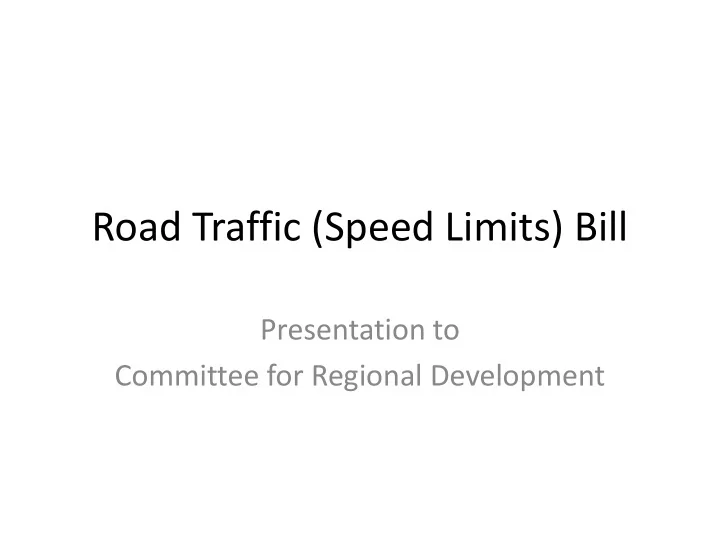

Road Traffic (Speed Limits) Bill Presentation to Committee for Regional Development
Road Traffic (Speed Limits) Bill • The Department fully supports the drive to improve safety on our roads. • We are a primary stakeholder in Northern Ireland’s Road Safety Strategy along with DOE and PSNI. • In the last 10 years we have spent £230m specifically on Local Transport and Safety Measures • Almost 500 20mph zones have been created - targeted measures, engineered to maximise benefits.
Existing Powers The Department already has powers to set speed limits. – Road Traffic Regulation (Northern Ireland) Order 1997 (Primary) – The Roads (Speed Limit) Order (NI) 2005 applied 20mph limit to a number of roads (Statutory Rule)
Current Policy The Department’s policy, “Setting Local Speed Limits in Northern Ireland” highlights that speed limits should be set as part of a package with other measures to manage vehicle speeds and improve road safety, thereby helping drivers to be more readily aware of the appropriate speed limit. The policy encourages and supports 20 mph limits and zones where there is a particular risk to vulnerable road users, especially in residential areas. There is further support for these limits and zones within the current Northern Ireland Road Safety Strategy to 2020.
Current Policy (2) When assessing the potential for a road to have a 20 mph speed limit introduced, many factors have to be taken into account, such as: – average speed; – collision history; – streetscape; – community support; – function; and – demographics.
Current Policy (3) Each road differs in terms of its suitability to have a reduced limit applied and the favoured solution has been to install engineering measures, such as road humps and central islands, so the reduced speed limit is, in effect, self enforcing. These traffic calming measures have proven to be very successful over the years and have helped to significantly reduce pedestrian and cyclist fatalities and serious injuries.
Road Traffic (Speed Limits) Bill • The blanket approach proposed will; – impose the limit without seeking support from those affected – create a culture of trying to opt out rather than opt in – have limited benefit in terms of speed reduction – have substantial associated costs
20mph Zones vs Limits 20mph zones use 20mph limits use physical measures traffic regulation such as humps, orders signified by the chicanes and gateway use of 20mph signs features to achieve speed reduction
Research on 20mph Zones A study carried out by the Transport Research Laboratory (TRL) into 250 such zones in 1996 found: • average speeds had fallen by nine miles per hour; • the annual total of accidents had fallen by 60%; • the number of accidents involving children had fallen by 67%; and • the number of incidents involving cyclists had fallen by 29%
Research on 20mph Limits A further study carried out by TRL in 1998, focussing on areas where a 20mph speed limit had been introduced without extensive traffic calming measures, found: • the use of 20mph signs alone, without associated traffic calming methods, led to speed reductions; but • 20mph speed restrictions, where reliance is placed primarily on the signing of the limit, are less effective in reducing traffic speeds than when zone treatment (traffic calming) is used.
Impact of the Bill • If the proposed Bill is approved by the Assembly, it will have resource implications for DRD. • Those areas where the 20mph limit would apply would need to be signed with 20mph limit signs. • Any lengths of road where a 30mph limit would still apply would then require to be signed up to 30mph, with repeater signs possibly being required at regular intervals.
Black dots represent signing locations
Financial Implication • Portsmouth Scheme cost £573k/410km • Edinburgh Scheme cost £214k/40km • NI Urban Unclassified 4300km • Using this metric would produce a NI figure of between £6m and £26m.
20’s Plenty for Us • Significant number of 20mph signed only schemes being implemented at a local level – Confirms some speed reduction post implementation – Potential for increased walking & cycling – Potential for collision reduction – Department needs to consider all of the available evidence to reach a view on the success of such schemes. • Keen to discuss with the Bill sponsor.
Preferred Approach • Enable not Impose • Use existing legislation to pilot schemes for 20 mph limits without additional self-enforcing engineering measures. • DRD has identified 5 suitable sites in conjunction with the PSNI. • Monitor the effectiveness of these schemes, along with similar pilots being undertaken by road authorities in Scotland, Wales and the Republic of Ireland. • Potential for low cost option in appropriate areas where there is a community desire.
Recommend
More recommend